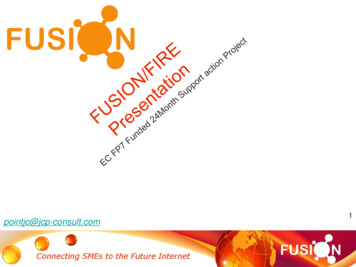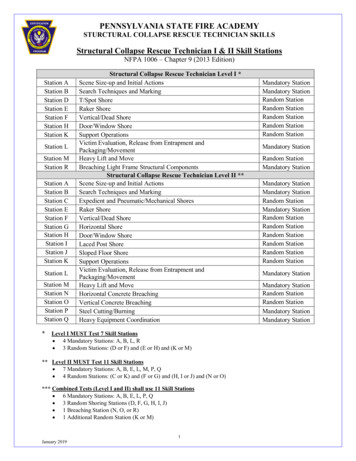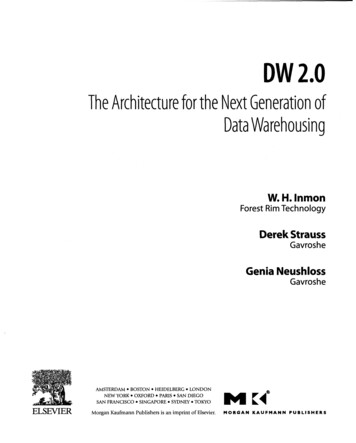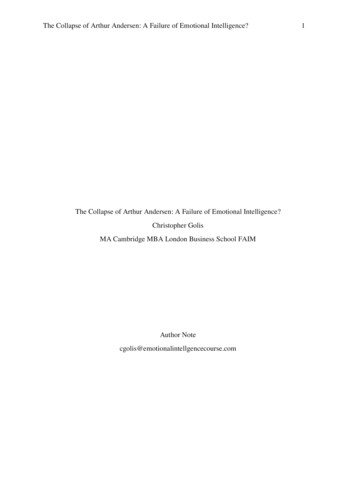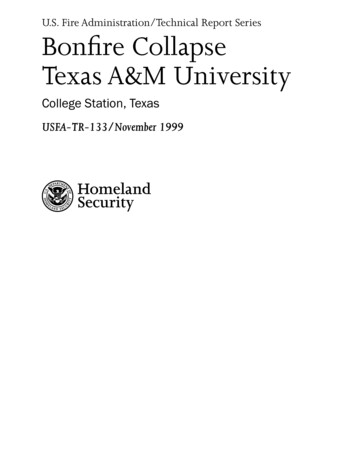
Transcription
U.S. Fire Administration/Technical Report SeriesBonfire CollapseTexas A&M UniversityCollege Station, TexasUSFA-TR-133/November 1999HomelandSecurity
U.S. Fire Administration Fire Investigations ProgramThe U.S. Fire Administration (USFA) develops reports on selected major fires throughout thecountry. The fires usually involve multiple deaths or a large loss of property. But the primarycriterion for deciding to do a report is whether it will result in significant “lessons learned.” Insome cases these lessons bring to light new knowledge about fire--the effect of building construction or contents, human behavior in fire, etc. In other cases, the lessons are not new but are seriousenough to highlight once again, with yet another fire tragedy report. In some cases, special reportsare developed to discuss events, drills, or new technologies which are of interest to the fire service.The reports are sent to fire magazines and are distributed at National and Regional fire meetings.The International Association of Fire Chiefs (IAFC) assists the USFA in disseminating the findingsthroughout the fire service. On a continuing basis the reports are available on request from theUSFA; announcements of their availability are published widely in fire journals and newsletters.This body of work provides detailed information on the nature of the fire problem for policymakerswho must decide on allocations of resources between fire and other pressing problems, and withinthe fire service to improve codes and code enforcement, training, public fire education, buildingtechnology, and other related areas.The U.S. Fire Administration, which has no regulatory authority, sends an experienced fire investigator into a community after a major incident only after having conferred with the local fire authoritiesto insure that the USFA’s assistance and presence would be supportive and would in no way interferewith any review of the incident they are themselves conducting. The intent is not to arrive duringthe event or even immediately after, but rather after the dust settles, so that a complete and objectivereview of all the important aspects of the incident can be made. Local authorities review the USFA’sreport while it is in draft. The USFA investigator or team is available to local authorities should theywish to request technical assistance for their own investigation.This report and its recommendations were developed by USFA staff and by Varley-Campbell &Associates, Inc., Miami and Chicago, its staff and consultants, who are under contract to assist theUSFA in carrying out the Fire Reports Program. The U.S. Fire Administration greatly appreciates thecooperation received from College Station Fire Department, Bryan Fire Department and Texas A&MUniversity.For additional copies of this report write to the U.S. Fire Administration, 16825 South Seton Avenue,Emmitsburg, Maryland 21727. The report is available on the Administration’s Web page at http://www.usfa.dhs.gov/
Bonfire CollapseTexas A&M UniversityCollege Station, TexasInvestigated by: John Lee Cook, Jr.This is Report 133 of the Major Fires Investigation Project conductedby Varley-Campbell and Associates, Inc./TriData Corporation undercontract EME-97-CO-0506 to the United States Fire Administration,Federal Emergency Management Agency.HomelandSecurityDepartment of Homeland SecurityUnited States Fire AdministrationNational Fire Data Center
U.S. Fire AdministrationMission StatementAs an entity of the Department of HomelandSecurity, the mission of the USFA is to reduce life and economic losses due to fireand related emergencies, through leadership, advocacy, coordination, and support.We serve the Nation independently, in coordination with other Federal agencies,and in partnership with fire protection andemergency service communities. With acommitment to excellence, we provide public education, training, technology, and datainitiatives.HomelandSecurity
TABLE OF CONTENTSOVERVIEW . . . . . . . . . . . . . . . . . . . . . . . . . . . . . . . . . . . . . . . . . . . . . . . . . . . . . . . . . . . . . . . . . . 2KEY ISSUES. . . . . . . . . . . . . . . . . . . . . . . . . . . . . . . . . . . . . . . . . . . . . . . . . . . . . . . . . . . . . . . . . . 3TEXAS A&M UNIVERSITY. . . . . . . . . . . . . . . . . . . . . . . . . . . . . . . . . . . . . . . . . . . . . . . . . . . . . . 4THE BRYAN-COLLEGE STATION METROPOLITAN AREA. . . . . . . . . . . . . . . . . . . . . . . . . . . . . . 5THE TRADITION . . . . . . . . . . . . . . . . . . . . . . . . . . . . . . . . . . . . . . . . . . . . . . . . . . . . . . . . . . . . . 5CONSTRUCTION. . . . . . . . . . . . . . . . . . . . . . . . . . . . . . . . . . . . . . . . . . . . . . . . . . . . . . . . . . . . . 6THE COLLAPSE. . . . . . . . . . . . . . . . . . . . . . . . . . . . . . . . . . . . . . . . . . . . . . . . . . . . . . . . . . . . . . 10DEPARTMENT’S CHAPLAINS’ PROGRAM. . . . . . . . . . . . . . . . . . . . . . . . . . . . . . . . . . . . . . . . . 17THE CRITICS. . . . . . . . . . . . . . . . . . . . . . . . . . . . . . . . . . . . . . . . . . . . . . . . . . . . . . . . . . . . . . . . 19THE INVESTIGATION . . . . . . . . . . . . . . . . . . . . . . . . . . . . . . . . . . . . . . . . . . . . . . . . . . . . . . . . 19AFTERMATH. . . . . . . . . . . . . . . . . . . . . . . . . . . . . . . . . . . . . . . . . . . . . . . . . . . . . . . . . . . . . . . . 23LESSONS LEARneD. . . . . . . . . . . . . . . . . . . . . . . . . . . . . . . . . . . . . . . . . . . . . . . . . . . . . . . . . . . 24APPENDICES. . . . . . . . . . . . . . . . . . . . . . . . . . . . . . . . . . . . . . . . . . . . . . . . . . . . . . . . . . . . . . . . 29Appendix A: Maps. . . . . . . . . . . . . . . . . . . . . . . . . . . . . . . . . . . . . . . . . . . . . . . . . . . . . . . . . . 31Appendix B: Photos . . . . . . . . . . . . . . . . . . . . . . . . . . . . . . . . . . . . . . . . . . . . . . . . . . . . . . . . 35Appendix C: Bonfire Facts. . . . . . . . . . . . . . . . . . . . . . . . . . . . . . . . . . . . . . . . . . . . . . . . . . . . 39Appendix D: List of Participating Agencies . . . . . . . . . . . . . . . . . . . . . . . . . . . . . . . . . . . . . . . 43Appendix E: List of the Deceased. . . . . . . . . . . . . . . . . . . . . . . . . . . . . . . . . . . . . . . . . . . . . . 45Appendix F: Executive Summary of the Final Report, Special Commission on the1999 Texas A&M Bonfire . . . . . . . . . . . . . . . . . . . . . . . . . . . . . . . . . . . . . . . . . . . 47
Bonfire CollapseTexas A & M UniversityCollege Station, TexasNovember 18, 1999Investigated by: John Lee Cook, Jr.The Federal Emergency Management Agency, United States Fire Administration gratefully acknowledges the cooperation of the staff of Texas A & M University and the members of the Bryan andCollege Station Fire Departments. Everyone who assisted in the preparation of this report was generous with their time, expertise, and counsel.Local Contacts:College Station Fire DepartmentP.O. Box 9960College Station, TX 77840(409) 764-3705Mike Donoho, Assistant ChiefGreg Pickard, Deputy ChiefDavid Giordano, Fire ChiefEric Hurt, Assistant ChiefThomas Goehl, Battalion ChiefBart Humphreys, Public Information OfficerAnne Kellett, Technical WriterTexas Engineering Extension Service(409) 845-5721Texas A&M UniversityBilly Parker, Program CoordinatorUrban Search and RescueFire Protection Training Division(409) 845-1153City of College StationP.O. Box 9960College Station, TX 77842(409) 690-2114Jan Van Cleve, Shift SupervisorEmergency Medical Services(409) 845-1525Ralph A. StaplinAssistant Emergency ManagementCoordinatorBryan Fire Department300 W. Wm. J. Bryan PKWYBryan, TX 77803(409) 821-5969Industrial Fire WorldDavid White, PublisherP.O. Box 9161College Station, TX 77842(409) 690-7559
OVERVIEWIn keeping with a ninety-year old tradition, fifty-eight people were working to construct the fourthtier of the 1999 bonfire stack on the campus of the Texas A&M University during the early morninghours of November 18, 1999. The bonfire is ignited every year on the eve of football game betweenTexas A&M and its arch rival the University of Texas at Austin. The fort-foot stack, consisting ofapproximately 5,000 logs, collapsed killing eleven people and sending twenty-eight to area hospitals. One of the injured would later die, bringing the total number killed in the incident to twelve.There were emergency medical personnel from the University’s Emergency Medical Service at thescene when the collapse occurred. EMS personnel immediately began to triage the injured bonfireworkers and to assist with the rescue effort.The first call to 9-1-1 was received by the City of College Station’s Emergency Communications Centerat 02:43 hours. The caller reported that the bonfire stack had collapsed on campus and as many asthirty people may be trapped. An engine company and an ALS ambulance from the College StationFire Department were dispatched and arrived on the scene within four and one half minutes.The first firefighters to arrive at the incident were confronted with a scene eerily reminiscent of thechildren’s game of pick-up-sticks. Command was established and additional resources were orderedimmediately upon realization of the magnitude of the event. The rescue and recovery effort lastedalmost twenty-four hours and involved over 3,200 individuals from over fifty different agencies.The magnitude and unique nature of the incident quickly attracted National attention. At the heightof the incident, approximately fifty satellite television trucks were broadcasting from the scene,including a number of Regional television stations that broadcast live from the scene throughout theevent. Several of the news agencies were from Spanish language only media organizations.There were three distinct phases of operations during the event. The first phase, involved the triageand rapid transport of the majority of the victims. Twenty-seven of the twenty-eight victims whorequired transport to a medical facility were transported within the first hour. A twenty-eighthvictim was severely pinned within the stack and could not be transported until he had been extricated. Phase Two of the incident involved the prolonged and tedious process of extracting victimswho were still alive from the stack. The final phase encompassed the removal of the bodies of thedeceased and the complete dismantling of the bonfire stack.Texas A&M University is a close-knit community and the tragic event had a significant impact notonly on the student body, but the local community as well. The out-pouring of assistance andsupport from the citizens of the area as well as from other universities throughout the State wasoverwhelming.Shortly after the incident, the President of the University appointed an independent commission ofinquiry to determine the cause of the collapse. The commission was assisted in their inquiry by anumber of experts as well as staff from the University. On May 2, 2000, the Commission releasedtheir much-anticipated findings.Their inquiry concluded that the 1999 bonfire collapsed due to a number of both physical andorganizational factors. According to the Report’s Summary of Findings, the structural collapse ofthe bonfire stack was driven by a containment failure in the first stack of logs. Two primary factorscaused this failure: the first was excessive internal stresses driven primarily by aggressive wedging of
USFA-TR-133/November 19993second stack logs into the first stack. The second was inadequate containment strength around thefirst stack, which resulted in structure failure.Hoop stress results from outward pressure in a cylindrical structure, like a barrel, that is due tointernal lateral forces. Design, shape, or even gravity can drive these forces. Hoop strength is theability of a cylindrical structure to contain hoop stress. Hoop strength is normally provided by somecontaining mechanism; the metal hoops on a barrel for example. The lack of metal cables on the firsttier reduced the hoop strength on the first tier and contributed to the structural collapse.Organizational factors resulted in an environment in which a complex and dangerous structurewas allowed to be built without adequate physical or engineering controls. Organizational failureincluded the absence of an appropriate written design or design process; a cultural bias, whichimpedes risk identification; and the lack of a proactive risk management approach.In addition to the special bonfire commission, OSHA and the Texas Alcoholic Beverage Commissionconducted inquiries into the collapse in order to determine if any of their regulations were violatedby any of the participants of the bonfire. Neither agency uncovered any act or violation, which warranted any further action.KEY ISSUESIssuesCommunicationsCommentsAn event of this magnitude can quickly exceed the capabilities of not only the communications systems utilized by the emergency responders, but also the telecommunications systems used by the community at large. University students were instructedto call home and to notify their families that they were okay. The enrollment at theUniversity exceeds 43,000 and the volume of calls that were made overwhelmed boththe telephone and cellular systems. Additionally, so many calls were placed to the localhospitals that their telephone systems were overloaded as well.College Station uses an 800 MHz trunked radio system. Bryan uses a VHF system,but had installed 800 MHz radios in their apparatus just ten days prior to the incident.College Station also has VHF radios for a totally redundant system. The use of cellularphones by rescuers and the news media contributed to the overloading of the cellularsystem for much of the event.Pre-Incident PlanningThere was an inter-jurisdictional emergency management plan in effect. A tabletopexercise had been conducted one week prior to the event with both cities and theuniversity participating. The local plan was up-to-date and the key people involvedknew each other and worked together on a regular basis. As one individual describedit, there was a “no need for an introduction” at the incident site. The University EMSservice had also conducted a MCI drill just two weeks prior to the incident.Incident ManagementMore than 3,200 people from more than fifty agencies were involved in the resolutionof the incident. An incident management system is absolutely critical for an incident ofthis magnitude. Fortunately, such a system was in place and was utilized to resolve theincident.Resource ManagementAn event of this magnitude requires a considerable amount of human and materialresources. The availability and source of these resources must be identified prior to anevent actually occurring. Resource lists must be kept up to date and procedures mustbe in place that allow for the rapid mobilization of the resources.continued on next page
IssuesCommentsCommunity ImpactThe outpouring of support and assistance from the community was overwhelming. Asone rescuer stated, you would ask for one of something and suddenly three wouldappear. Local restaurants supplied food to the rescuers and area hotels providedaccommodations for the family members of the victims. The tragic loss was felt in thetight-knit community as well.Rumor ControlSo much misinformation was being broadcast about the incident that the television setsin the two local hospitals were all turned off to reduce the anxiety of the friends andfamily members of the victims of the accident. The PIO staff at the incident did a goodjob, however, of conducting timely briefings to keep the media informed. Over fiftytelevision satellite trucks responded to the incident.TEXAS A&M UNIVERSITYTexas A&M University is located in College Station, Texas approximately equidistant from three of theten largest cities in the United States, Houston, Dallas and San Antonio, and the State capital, Austin.The University’s enrollment in the fall of 1999 was 43,442 students, which places the school amongthe five largest universities in the Nation. Originally founded as an all male institution, women nowconstitute almost half of the total enrollment. African Americans and Hispanics comprise approximately eleven percent of the student body.The first public institution of higher education established in Texas, the University opened its doorswith forty-eight students on October 4, l876 as the Agricultural and Mechanical College of Texas.A&M is a land grant; sea grant and space grant institution and owes its origin to the Morrill Act of1862, which established the nation’s land-grant college system.In 1963, the name of the institution was changed to Texas A&M University. Today, the school occupies a 5,200-acre campus with more than 100 building, with an assessed value of over 1 billion.The University is the home of the George Bush Presidential Library and the Texas A&M Corps ofCadets. Excluding the service academies, the Corps is the largest uniformed student organization inthe Nation with ROTC programs in all branches of the armed services. The current strength in theall-voluntary program is approximately 2,200 students.In 1929, the State Firemen and Fire Marshal’s Association of Texas chose A&M as the site for a training program for volunteer firefighters. In 1931, the State Legislature instructed A&M to create andoperate a permanent training school for both career and volunteer firefighters. In 1954, the trainingmandate was expanded to include industrial firefighters. The Firemen’s Training School (FTS) is nota part of the Texas Engineering Extension Serve (TEEX), a division of the University, and has grownto become one of the largest fire training schools in the world.Texas Task Force One, a FEMA Urban Search and Rescue Team, is also headquartered at FTS. TheUSAR Team maintains more than 1.3 million dollars worth of state-of-the-art equipment and itsmembers include 186 emergency services personnel from forty-eight organizations and departmentthroughout the State. Members are divided into three sixty-two-member teams, which are on athirty-day rotational call. Each team has five components: a command structure, a rescue group, amedical group, a technical group, and a search group that has a canine search component.
USFA-TR-133/November 19995THE BRYAN-COLLEGE STATION METROPOLITAN AREACollege Station has a population of 62,000 and is located in the Brazos River Valley of east centralTexas, about 140 miles north of the Gulf of Mexico. The Brazos County community was named as arailway stop by the Postal Service in 1877. Contiguous with the City of Bryan, College Station wasplanned, as a model community by college professors when the college could no longer accommodate their living needs on campus. When A&M opened its doors to women in the 1960’s, the city’spopulation began to rapidly increase and is currently one of the fastest growing metropolitan areasin the nation.Prior to 1970, fire protection was provided by a volunteer fire department that was operated by theUniversity. In 1970, the city created its own fire department, which is now all career with eightyfour employees. Sixty-nine personnel are assigned to suppression shifts and are deployed in fourstations and staff eight pieces of apparatus. A fifth station has been approved and is scheduled toopen in 2003. The department is organized in three divisions; Administration, Operations, and theFire Marshal’s Office. The Operations Division provides EMS transport service within the city and bycontract in the southern half of Brazos County.Firefighters work three shifts (24/48). A Battalion Chief commands each shift and minimum staffingis seventeen per shift, three per engine and ladder company, and two for an ambulance. Firefightersrespond to over 4,000 incidents each year, with EMS calls constituting approximately 70 percent ofthe total incident volume.The City of Bryan, population 61,400, borders College Station to the north. Bryan is the countyseat of Brazos County, population 130,000. The original town site was established in 1859 on 640acres and the earliest recorded population indicated that there were between 300 and 500 residents.The City was incorporated in 1871 and has grown over the years to its current size of 32.3 squaremiles.The Bryan Fire Department was organized on July 5, 1871 and was incorporated by the State of Texasas Hook and Ladder Company Number One. In the 1880’s, the volunteer company purchased the firstLaFrance steam fire engine to be used in Texas. The first career firefighter was hired in 1921 and nowthe department is all career with a staff of seventy-eight. The Department operates four stations andstaffs four engine companies, one aerial platform, and two ambulances. Firefighters work a 24/48schedule and a Deputy Chief is in command of each of the three shifts. The department responds tomore than 7,000 calls for service each year, approximately 60 percent are for EMS calls.THE TRADITIONTexans take their football very seriously, whether it is a peewee game played in the local park onSaturday morning or a Sunday afternoon game at Texas Stadium involving the Dallas Cowboys. Yet,one would be hard pressed to find a more intense rivalry than the annual football game betweenTexas A&M University and its arch rival, the University of Texas at Austin (UT and also known asTU). The game is traditionally played each year during the week of Thanksgiving and one of the keyevents surrounding the game is the burning of the bonfire, which takes place on the A&M campuson the eve of the game.The ninety-year old tradition has evolved over the years, but traces its origin to 1909 when studentsignited a pile of trash gathered on the spur of the moment in anticipation of the game with UT.
The earliest available photograph of the bonfire dates from 1928 and shows a bonfire stack that wasconstructed of wooden pallets, tree limbs, and other similar materials. In 1943, the bonfire gainedincreased notoriety when it was featured in a Hollywood motion picture entitled We’ve Never BeenLicked. In 1945, the first center pole was used and the bonfire was constructed entirely of logs in ateepee configuration, which was topped by an outhouse The wedding cake configuration of recentbonfires dates to 1978.Attendance at the annual ritual has grown over the years and ranges from 30,000 to 70,000 spectators, depending on such factors as weather and the quality of A&M’s and UT’s football teams. The1999 bonfire would have been the 89th one to be burned. The bonfire was cancelled in 1963 inresponse to the assassination of President Kennedy in Dallas on November 22nd.The 1999 bonfire was either the 90th or 92nd to have been built, depending upon one’s point ofview. The bonfire stack collapsed without incident in 1957 and again in 1994. Both stacks werehastily rebuilt and were burned as scheduled. Hence the dispute about the number of stacks constructed during the last ninety years. Appendix C provides a chronological history of significantevents surrounding the bonfire and provides a description of the command hierarchy used to construct the bonfire stack.Over the years, the bonfire has been held a number of places on campus. Since 1992, the event hasbeen held at the Polo Fields on the north side of the campus. The bonfire is a student-managed eventand approximately 125,000 man-hours are expended to construct the stack. Nearly 5,000 studentsand former students participate in the cutting, hauling, and stacking of the 6,000 to 8,000 logs thatare used to construct the bonfire structure. Area landowners wishing to clear their land donate thetrees used in the event.The bonfire event has not been without it critics, particularly environmentalists who decry theimpact of cutting the trees and the air pollution generated by the fire. Since 1991, however, studentshave carried on a new tradition by planting approximately 10,000 replacement trees each spring toshow support for both the bonfire and the environment.The saga of the bonfire is rich in folklore. UT students have attempted to ignite the bonfire prior tothe scheduled event a number of times. Among their more creative efforts were attempts in 1933and 1948 to drop firebombs from airplanes. None of the attempts, however, have proven to besuccessful.The first seventy bonfires were male affairs only. In 1979, women were first allowed to help construct the bonfire. For much of its history, Texas A&M was an all male institution. Women wereadmitted to the University during the 1960’s and are now very much a part of the activities surrounding the event.CONSTRUCTIONIn 1999, cutting began on October 3rd and the stacking process would have normally taken fromtwo to three weeks to complete. Prior to the actual construction of the stack, the ground is limestabilized and compacted as a precaution. In 1994, heavy rains just prior to the bonfire caused thestack to collapse when the ground underneath the stack became unstable. A center pole, first usedin 1945, is set and the logs are stacked in six tiers around the center pole in a wedding cake design.The 1999 center pole arrived on site on October 30th.
USFA-TR-133/November 19997The Center pole is constructed using two utility poles, which are spliced together. The 1999 centerpole was 105 feet long and was buried approximately fourteen feet in the ground. The two matching notches, approximately ten feet long, are cut into the poles and the notches are joined togetherwith five gallons of glue. Eight long bolts and four steel plates are added to secure the joint. A 3/8inch cable is then wrapped around the joint and the cable is secured to the pole with steel staples.The diagram in Figure One, provides an illustration of the technique employed in the constructionof the center pole.Figure 1. Center Pole DesignA top cap is added to the center pole and serves as an attachment point for two “tag lines” that gothrough a series of pulleys. The tag lines are used to raise the timbers. Guy ropes, consisting of oneinch manila ropes have a rated load capacity of 1,900 pounds, are also attached and are fastened tofour light towers for stability, as illustrated in Figure Two, below. The lights are necessary since mostof the construction takes place after dark. Approximately fifty carabiners are secured to top of thepole, which are used by the workers on the stack. They are suspended with ropes that connect tocarabiners and assist with the hoisting of the logs onto the stack. Each log is individually secured tothe stack with bailing wire.
Figure 2. Bonfire Diagrams
USFA-TR-133/November 19999There are no official guidelines regulating the actual construction of the stack, but recommendationsare passed down each year from the Red Pots. The Red Pots are a group of nine seniors and ninejuniors that actually manage the overall construction of the bonfire. The Red Pot in overall commandis known as the Heat Stack. See Appendix C for a complete breakdown of the organizational structure of the group that constructs the bonfire.By 1969, the bonfire stack had grown to over 109 feet as each succeeding class tried to outdo theone before. Since 1970, however, the finished stack has been intended to be limited to fifty-five(55) feet in height and forty-five feet in width as a safety precaution. Surveying equipment is usedto make sure that the center pole is straight and to mark how high each of the six tiers will reach.Four perimeter poles are also placed 150 feet away and ropes are stretched from the perimeter polesto center pole and tension is placed on the lines in order to hold the wooden spine together.The majority of the work is performed manually, but cranes are used to assist in lifting the logs ontothe higher tiers. The cranes are donated and there are volunteers from construction companies onsite during the construction process to offer advice to the students, although the advisors do not participate in the actual construction of the stack. Construction crews work in two shifts. The first shiftworks from 18:00 hours until midnight. The second shift starts at midnight and works until 06:00hours. Fortunately, a rigid accountability system is used to monitor the workers at the constructionsite. Many workers do not routinely carry identification on their person during a normal shift andthe accountability system proved invaluable in the identification of the collapse victims.Fay Engineering Corporation of Denver, Colorado prepares a historical description and examinationof the bonfire for the special commission, which investigated the 1999 collapse. As a part of theirresearch, a composite design was prepared based upon photos of the bonfire from 1978 to 1998.The photos were located in the archives of Cushing Memorial Library. A diagram of the compositestack is illustrated in Figure Three, and represents an average of the cumulative designs.Figure 3. Composite Design
10U.S. Fire Administration/Technical Report SeriesIn addition, the dimensions of the composite design are listed in Table One, below.Table 1. Composite Bonfire Measurements, 1978-1998Overall Height:Base Diameter:Number of Stacks:Height at 4th Level:72’57’659’StackHeightTop DiameterBottom urce: Fay Engineering CorporationThe bonfire stack is “crowned” with an outhouse affectionately known as the “T.U. tearoom or frathouse”. The outhouse is approximately seven feet tall and is not included in the fifty-five foot standard construction height. An Austin highway sign is also placed at the top and traditionally lists thesophomore class year as the miles to Austin. In previous times, the outhouse and highway sign were“acquired”, but now are built by the students or are donated for the event. The bonfire is ignitedby using 700 gallons of diesel fuel, which is applied by members of the Fire Training School st
College Station Fire Department P.O. Box 9960 College Station, TX 77840 (409) 764-3705 David Giordano, Fire Chief Eric Hurt, Assistant Chief Thomas Goehl, Battalion Chief Bart Humphreys, Public Information Officer City of College Station P.O. Box 9960 College Station, TX 77842 (409) 690-2114 Ralph A. Staplin Assistant Emergency Management .
